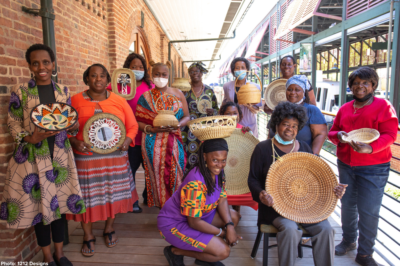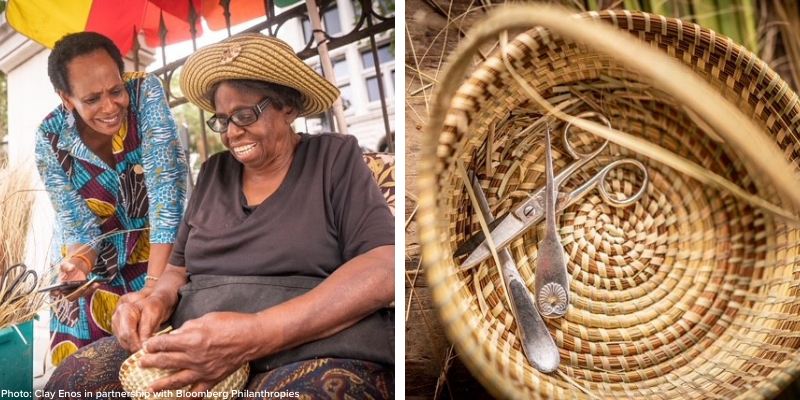Nest and Bloomberg Philanthropies Launch Hands to Heritage

The Gullah-Geechee people are the descendants of enslaved West Africans who were brought to the US to plant rice. In servitude, the Gullah discovered the materials necessary to craft large fanner baskets to winnow rice, similar to those from their homeland, which separate the chaff from the hull. Through a combination of sweetgrass, pine needles, bulrush, and palmetto palm, the enslaved Gullah carried on the weaving traditions that were native to their homeland as they created baskets of exquisite patterns and intricate weaves. Today, the creation of these baskets continues and is embedded into the cultural landscape of their descendants who continue to reside in the Lowcountry of Charleston and the nearby barrier islands.
The Gullah Basket Weavers of today continue this unique basket weaving technique using local sweetgrass reeds, a tradition that can be traced back over 10 generations. It is for this reason that the Gullah take great pride in their craft and legacy and continue to prioritize teaching the future generation. The weavers’ primary channel for market access has been a seven mile-stretch of Highway 17 that became known as “Sweetgrass Basket Makers Highway” until 2010, when a Sweetgrass Pavilion was built to showcase the basket tradition. Meanwhile, the baskets produced by the 250–300 Gullah-Geechee weavers who are keeping this craft tradition alive have attracted the attention of museums, ranging from the Smithsonian to the Burke Museum in Seattle, yet their weaving tradition remains unknown to many Americans.
An ocean away, a cooperative of weavers are also creating baskets. Following the Rwandan genocide, in an effort to restore peace and rebuild community, a Rwandan basket weaving cooperative formed. Gahaya Links began by collaborating and employing women who were deeply affected both economically and mentally as a pathway to national recovery. While basket weaving has been a part of Rwandan culture for centuries, it now took on a new meaning to become a symbol of peace and reconciliation, while bringing economic independence to the talented artisans.

Together with Nest’s longtime partner, Bloomberg Philanthropies, we have designed a unique program to connect the Gullah basket weavers with the Rwandan basket weaving community to collaborate and co-create a new “peace basket.” Their creation will be a shared celebration of both of these artisans’ distinct techniques which are intricately tied to each of their communities’ histories.
Through this program, Nest will provide business development and brand partnership expertise to leaders in the Gullah community. This effort will raise the profile of the Gullah within the American craft space—and encourage more ethical sourcing here and abroad–generating local, national and international interest in this largely overlooked craft community despite the craft’s long history. In time, Nest hopes to leverage this increased awareness and interest to expand the weavers’ market access through online retail shops, as well as brand and retail partners.
Bloomberg Philanthropies, Nest’s largest multi-year supporter, is powering a system-wide transformation that stands to revolutionize work in the handworker economy not only with this project in South Carolina but across the globe. Over the last seven years, our partnership has increased equitable employment opportunities for artisans and makers while advocating for their overall wellbeing, taking a multi-stakeholder approach which enables market forces to play a larger role in this emerging sector.
Since the inauguration of our partnership, we have expanded our reach by 2951%, our resources and programs now reaching over 250,000 workers in over 100 countries. Globally, our reach expanded through an increase in strategic brand partnerships from one core partner in 2014 to 38 in 2020. And, our US-based program, Makers United, expanded from 28 businesses to over 700 businesses through fellowship placements, immersive training programs and the creation of accessible resources.
Photo Credit (all images): Clay Enos in partnership with Bloomberg Philanthropies
Tags: Makers United